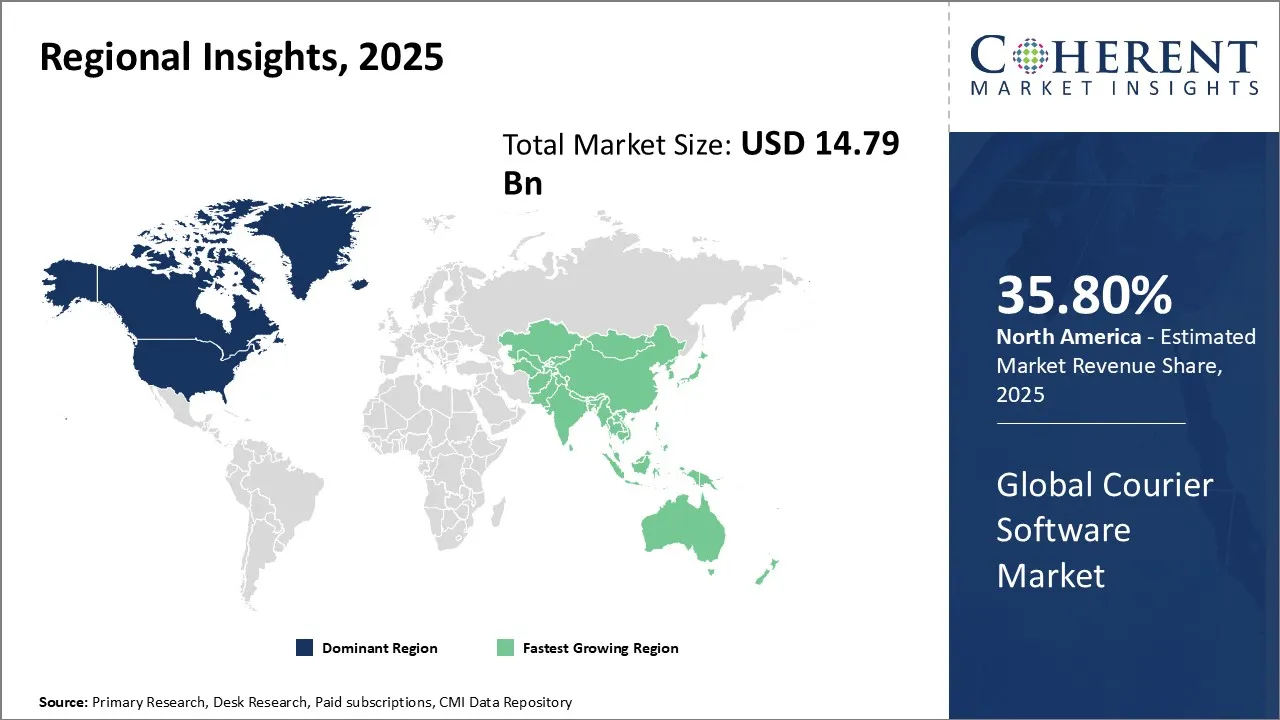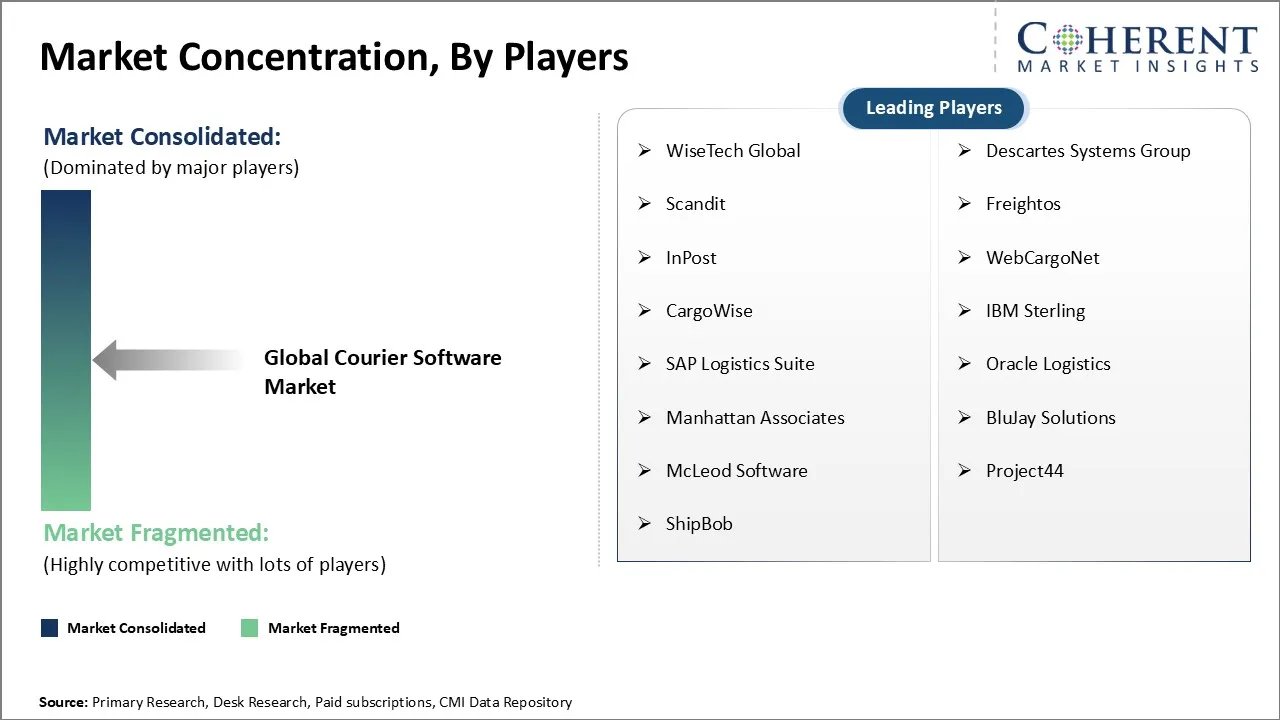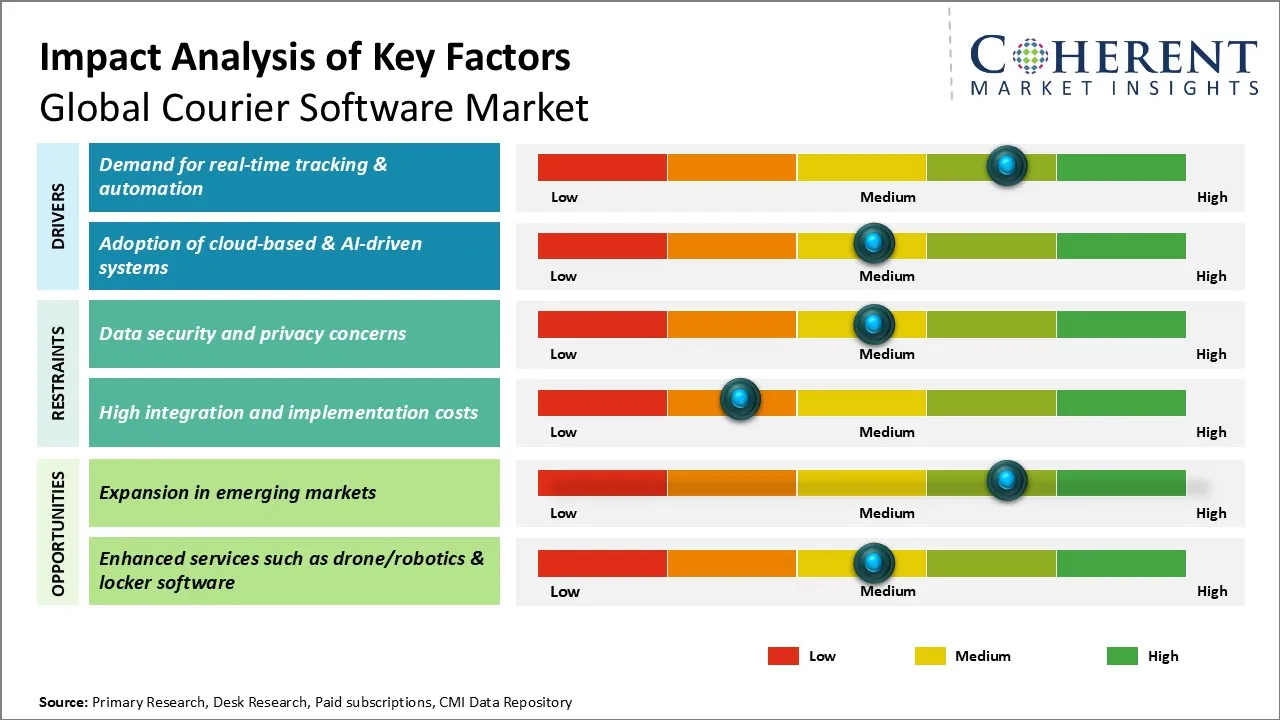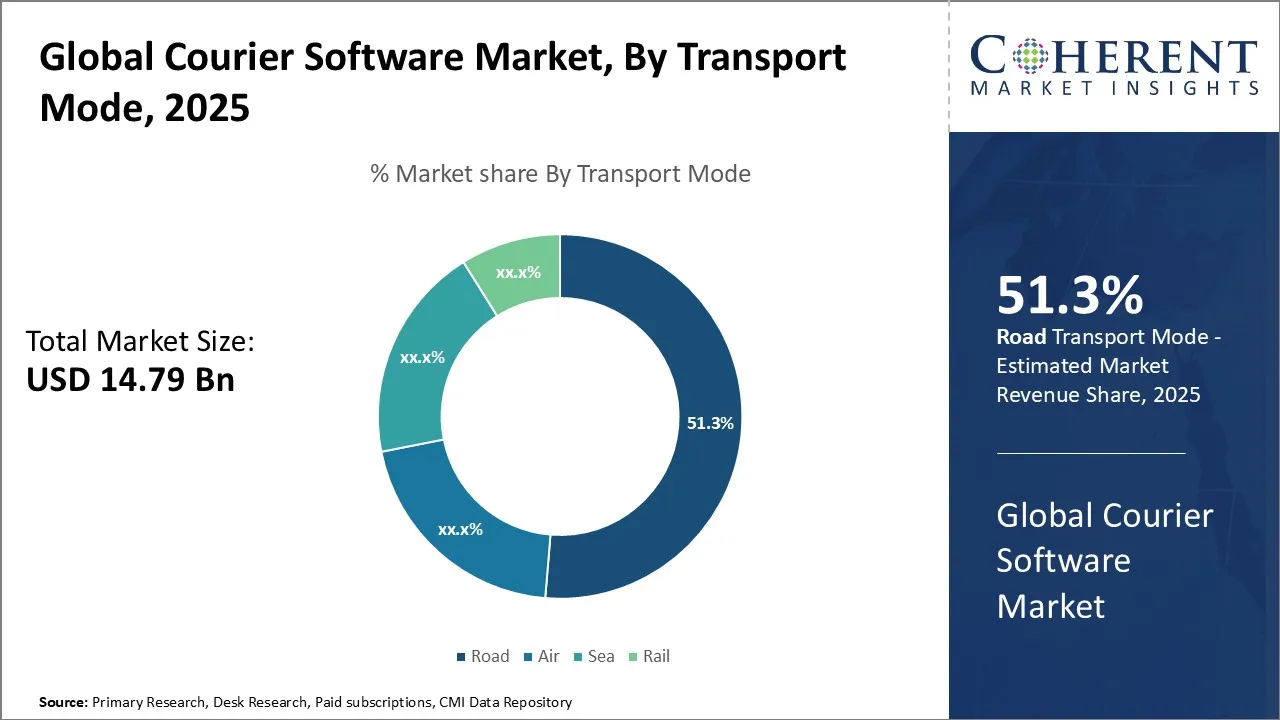Global Courier Software Market Size and Forecast – 2025-2032
The Global Courier Software Market is estimated to be valued at USD 14.79 billion in 2025 and is expected to reach USD 26.69 billion by 2032, exhibiting a compound annual growth rate (CAGR) of 8.8% from 2025 to 2032.
Key Takeaways of the Courier Software Market:
- The road segment leads the market holding an estimated share of 51. 3% in 2025.
- The shipping/distribution management segment leads the market holding an estimated share of 38. 9% in 2025.
- North America is estimated to lead the market with a share of 35. 8% in 2025. Asia Pacific, holding a share of 29.9% in 2025, is projected to be the fastest growing region.
Market Overview:
Market trends indicate a strong shift towards automation and digitization within the courier software sector, with companies prioritizing cloud-based platforms for scalability and ease of access. Growing urbanization and e-commerce expansion adds to market growth as customers are now expecting faster delivery and improved transparency, which results in continuous innovation. Additionally, the adoption of machine learning algorithms is enhancing predictive analytics, enabling better route planning and cost efficiencies in courier services.
Current Events and their Impact:
|
Current Events |
Description and its impact |
|
Geopolitical Tensions in Eastern Europe |
|
|
Technological Advancements in AI and IoT Integration |
|
Uncover macros and micros vetted on 75+ parameters: Get instant access to report
Global Courier Software Market Insights, by Transport Mode – Road Segment Leads Owing to its Extensive Connectivity and Operational Flexibility
The dominance of the road segment, holding an estimated share of 51.3% in the global courier software market in 2025, can primarily be attributed to the unparalleled reach and accessibility offered by road networks. The expansive road infrastructure in both urban and rural regions facilitates door-to-door delivery, making road-based courier software solutions indispensable for managing route planning, real-time tracking, and optimizing delivery schedules.
Furthermore, the dynamic nature of consumer demands, including increased e-commerce activities and the expectation for faster deliveries, heavily favors road transport. Courier software tailored for road transport incorporates advanced algorithms for route optimization, traffic pattern analysis, and fleet management, which collectively reduce delivery times and operational costs. The adaptability this segment enjoys also stems from the diverse vehicle types utilized – ranging from motorcycles and vans to trucks – allowing courier firms to handle parcels of varying sizes and urgency with flexibility.
Another key driver fueling the demand for road transport courier software is its ability to integrate with last-mile delivery technologies such as GPS, IoT-enabled vehicle tracking, and mobile applications for delivery personnel. These integrations facilitate enhanced transparency for customers, real-time status updates, and efficient inventory handling during transit. Additionally, road transport is less constrained by geopolitical boundaries compared to air or sea transport, which often involve complex customs and regulatory procedures, making software solutions that cater to road transport more straightforward and widely adopted.
Global Courier Software Market Insights, by Application - Shipping/Distribution Management Leads Driven by the Need for Seamless Logistics Orchestration and Efficiency
The shipping/distribution management segment is expected to hold a share of 38.9% in the global courier software market in 2025. Courier software solutions designed for shipping and distribution management streamline end-to-end logistics processes. This helps improve operational visibility and control.
As multi-channel retail and cross-border deliveries become more popular, courier companies need to smoothly coordinate shipments across different transport modes, warehouses, and distribution centers. Shipping/distribution management software includes tools for shipment scheduling, load optimization, route allocation, and carrier selection, helping reduce delays and freight costs.
Also, these software platforms improve customer experience and make possible real-time communication by enabling transparent shipment tracking, automated status notifications, and exception management. These features also help courier firms to proactively address disruptions such as weather-related delays or logistical bottlenecks.
Apart from this, regulatory compliance and data security requirements around shipping activities have become a lot more complex, prompting the adoption of robust software solutions that can automate documentation, customs clearance, and audit trails.
Impact of AI on the Courier Software Market
AI-driven algorithms make possible real-time route optimization, demand forecasting, and dynamic scheduling, reducing fuel consumption and delivery time. Machine learning models are increasingly used to analyze vast data streams—such as traffic patterns, weather, and delivery history—to predict delays and suggest corrective actions.
WiseTech Global, a logistics software provider, has integrated AI and machine learning features into its flagship platform, CargoWise. These features help logistics providers automate customs compliance, optimize global freight movements, and make data-driven decisions. In 2024, the company announced enhancements using AI to streamline last-mile delivery tracking and improve predictive analytics for shipment ETAs, helping clients reduce delivery failures and improve customer satisfaction.
Regional Insights:

To learn more about this report, Download Free Sample
North America Courier Software Market Analysis and Trends
North America, holding a share of 35.8% in 2025, is expected to dominate the global courier software market. This can be attributed to its well-established logistics infrastructure, high adoption of advanced technologies, and presence of key industry players. The region benefits from mature e-commerce markets and strong demand for efficient last-mile delivery solutions. In 2024, FedEx introduced Roxo, its autonomous delivery robot, integrated with its courier management software and IoT ecosystem. Powered by AI and real-time data analytics, Roxo navigates sidewalks and roadways to deliver small parcels within local neighborhoods.
Major companies such as Descartes Systems Group, Onfleet, and Bringg have developed comprehensive courier management platforms tailored to the complex supply chains of North America. These companies drive market growth by offering features like route optimization, real-time tracking, and integrated payment gateways. The strong presence of courier and freight companies, alongside reliable internet connectivity and high smartphone penetration, creates an ecosystem conducive to rapid software adoption.
Asia Pacific Courier Software Market Analysis and Trends
Meanwhile, the Asia Pacific region, holding a share of 29.9% in 2025, is expected to exhibit the fastest growth in the courier software market due to rapid urbanization, a booming e-commerce sector, and increasing smartphone and internet user base. Expanding middle-class consumer segments and government initiatives like “Digital India” and smart logistics hubs in China and Southeast Asia provide a robust foundation for technology integration in courier services. Deliveree, a leading logistics tech startup in Southeast Asia, launched its AI-powered Smart Pricing Engine in 2024. This system uses machine learning to dynamically calculate delivery pricing based on real-time supply-demand data, route complexity, vehicle availability, and local traffic conditions.
The fragmented courier software market across countries such as India, China, and Indonesia creates a significant opportunity for software providers to streamline operations and improve efficiency. Key players like SF Express in China and eCourier in India are influential in digitizing their operations and fostering local technology ecosystems. The growing number of startups focusing on last-mile delivery innovations also accelerates market penetration.
Global Courier Software Market Outlook for Key Countries
U.S. Courier Software Market Analysis and Trends
The U.S. is characterized by the presence of several global courier giants and technology innovators. Companies such as Onfleet and Descartes have anchored themselves firmly by catering to both large-scale logistics operators and smaller last-mile delivery services. The U.S. benefits from supportive regulatory frameworks that encourage the use of AI and IoT in transportation. The focus on sustainability and delivery optimization drives the continuous upgrade of courier software, making the U.S. a hotspot for innovation and investment in this field.
China Courier Software Market Analysis and Trends
China courier software market is propelled by one of the largest e-commerce markets globally, alongside a dense network of logistics companies and courier services. Government initiatives promoting smart logistics and infrastructure development in urban centers accelerate the adoption of advanced courier management software. Key players like SF Express leverage technology to maintain competitive delivery speed and service quality. The China courier software market’s emphasis on real-time data analytics and automation reflects its broader push towards Industry 4.0 technologies.
India Courier Software Market Analysis and Trends
India’s growing e-commerce and retail sectors are significant drivers for courier software adoption. The government’s Digital India campaign and improved internet infrastructure have created a fertile environment for technology solutions in logistics and courier services. Companies like Delhivery and eCourier have contributed substantially by incorporating route optimization and automated dispatch in their platforms, improving the efficiency of deliveries across both urban and rural areas. The market is marked by a high degree of fragmentation, providing ample opportunities for software vendors to innovate and consolidate.
Germany Courier Software Market Analysis and Trends
Germany serves as a leading courier software market in Europe owing to its highly developed logistics industry and robust manufacturing sector. Government policies emphasize digital transformation and sustainability, encouraging the adoption of eco-friendly delivery solutions integrated with robust courier management software. Firms like SAP and PTV Group have played pivotal roles in delivering customized software solutions that address complex routing and scheduling challenges faced by European courier companies. The country’s strategic location in Europe and strong trade links further augment its standing in the market.
Market Players, Key Development, and Competitive Intelligence:

To learn more about this report, Download Free Sample
Key Developments:
- In May 2025, WiseTech Global, a developer of leading logistics execution software CargoWise, entered a binding agreement to acquire U.S.-based E2open Parent Holdings, Inc., a provider of SaaS-based solutions in the global logistics value chain.
- In April 2025, DSV completed the acquisition of Schenker, creating a world-leading player in the transport and logistics industry
- In April 2025, Poland-based parcel locker network, InPost, bought the U.K. delivery firm, Yodel. The deal created third largest independent delivery business serving online retailers in Britain.
- In January 2025, InPost announced plans to invest USD 1.37 billion (£1 billion) in the U.K. by 2029, expanding its parcel locker network, creating up to 12,000 jobs, and addressing growing demand in its fastest-growing market.
Top Strategies Followed by Courier Software Market Players
- Established players dominate the sector primarily through substantial investments in research and development (R&D), enabling the continuous innovation of high-performance, scalable courier software solutions suited for a wide range of logistics and delivery needs.
- WiseTech Global, a leading logistics software company, invested over USD 270 million (AUD 400 million) in R&D between 2022 and 2024. The company continuously enhances its CargoWise platform by integrating AI-driven customs automation, predictive analytics, and global compliance tools.
- Mid-level players in the courier software market typically adopt strategies centered on cost-effectiveness and value-driven solutions. Their offerings often balance quality with affordability, targeting price-sensitive customer segments such as small and medium-sized enterprises (SMEs) and local courier services that require robust yet economical software.
- ShipRocket, a rapidly growing logistics software provider in India, has strategically positioned itself by offering affordable shipping solutions tailored for SMEs and D2C brands. Its cloud-based courier aggregation and real-time tracking platform supports over 25 courier partners. In 2024, it launched “ShipRocket X,” an international shipping tool aimed at price-sensitive Indian exporters, offering economical delivery rates with simplified customs documentation.
- Small-scale players in the courier software market focus on carving out niche segments by promoting specialized features or innovative product functionalities that address unique market demands.
- Onfleet, a smaller but fast-growing player based in California, U.S., focuses exclusively on last-mile delivery optimization. It offers a sleek, easy-to-integrate platform with real-time driver tracking, predictive ETAs, and customer messaging tools. By concentrating solely on last-mile logistics for sectors like food delivery, pharmacy, and retail, Onfleet differentiates itself from broader platforms and has gained traction among urban-focused and time-critical service providers.
Market Report Scope
Courier Software Market Report Coverage
| Report Coverage | Details | ||
|---|---|---|---|
| Base Year: | 2024 | Market Size in 2025: | USD 14.79 Bn |
| Historical Data for: | 2020 To 2024 | Forecast Period: | 2025 To 2032 |
| Forecast Period 2025 to 2032 CAGR: | 8.8% | 2032 Value Projection: | USD 26.69 Bn |
| Geographies covered: |
|
||
| Segments covered: |
|
||
| Companies covered: |
WiseTech Global, Descartes Systems Group, Scandit, Freightos, InPost, WebCargoNet, CargoWise, IBM Sterling, SAP Logistics Suite, Oracle Logistics, Manhattan Associates, BluJay Solutions, McLeod Software, Project44, and ShipBob |
||
| Growth Drivers: |
|
||
| Restraints & Challenges: |
|
||
Uncover macros and micros vetted on 75+ parameters: Get instant access to report
Market Dynamics

To learn more about this report, Download Free Sample
Global Courier Software Market Driver – Demand for Real ‑ time Tracking & Automation
Customers today expect complete visibility of their shipments throughout the delivery process, prompting courier companies to adopt advanced software solutions that provide instant updates and accurate tracking information. Real-time tracking not only boosts customer satisfaction by reducing uncertainty but also enables service providers to streamline logistics and swiftly respond to any disruptions.
Additionally, automation plays a crucial role in optimizing route planning, dispatch management, and inventory control, minimizing manual intervention and human error. This integration of automated workflows with real-time data analytics helps courier companies improve delivery accuracy and reduce operational costs. For instance, in 2023, Descartes launched an upgraded version of its Real-Time Transportation Visibility Platform (RTTVP), integrated with AI and IoT sensors to provide live shipment tracking, automated alerts, and predictive ETAs. As the market increasingly prioritizes faster, more transparent, and efficient shipment processes, software platforms offering robust tracking capabilities and automation features are becoming indispensable tools for competitive advantage in the courier industry.
Global Courier Software Market Opportunity – Expansion in Emerging Markets
The global courier software market presents a significant growth opportunity through expansion into emerging markets such as Asia Pacific, Latin America, and Africa. These regions are witnessing rapid urbanization, increasing e-commerce penetration, and rising consumer demand for efficient delivery services, all of which drive the need for advanced courier software solutions. In countries like India, Brazil, and South Africa, the growth of small and medium enterprises (SMEs) coupled with improving digital infrastructure creates fertile ground for software providers to offer scalable, cost-effective, and customizable platforms tailored to diverse logistics needs. For instance, Lalamove expanded aggressively into Latin America in 2023, launching services in Brazil and Mexico to tap into underserved, high-demand urban logistics markets.
The increasing smartphone and internet penetration rates in these regions also facilitate the implementation of mobile-centric courier software applications, addressing last-mile delivery challenges effectively. Furthermore, local courier companies are actively seeking technology upgrades to compete with global players, making them prime candidates for adopting innovative software solutions that provide real-time tracking, route optimization, and automated billing. This market expansion not only opens avenues for revenue growth but also encourages partnerships and collaborations with local logistics providers, boosting market penetration and customer acquisition prospects in these high-growth regions.
Analyst Opinion (Expert Opinion)
- The shift from reactive to predictive logistics is accelerating. Courier software is increasingly infused with AI models that forecast delivery delays, optimize routes based on real-time variables, and automate dispatch decisions. Players like WiseTech and Descartes are embedding predictive intelligence directly into their platforms, setting a new standard for proactive logistics.
- Sensor-enabled tracking—once a premium feature—is now a market expectation. Courier platforms integrating IoT devices for real-time parcel condition, location, and handling are not just enhancing customer trust but enabling smart exception handling. This tech layer is especially critical in sensitive verticals like pharma and food logistics.
- A quiet revolution is unfolding with the rise of low-code/no-code courier management tools. These platforms allow SMEs and mid-sized logistics firms to rapidly configure workflows, customize UIs, and automate processes without deep technical expertise—lowering entry barriers and fueling adoption in emerging economies.
Market Segmentation
- Transport Mode Insights (Revenue, USD Bn, 2020 - 2032)
-
- Road
- Air
- Sea
- Rail
- Application Insights (Revenue, USD Bn, 2020 - 2032)
-
- Shipping/Distribution Management
- Goods/Inventory Management
- Others
- Regional Insights (Revenue, USD Bn, 2020 - 2032)
- North America
- U.S.
- Canada
- Latin America
- Brazil
- Argentina
- Mexico
- Rest of Latin America
- Europe
- Germany
- U.K.
- Spain
- France
- Italy
- Russia
- Rest of Europe
- Asia Pacific
- China
- India
- Japan
- Australia
- South Korea
- ASEAN
- Rest of Asia Pacific
- Middle East
- GCC Countries
- Israel
- Rest of Middle East
- Africa
- South Africa
- North Africa
- Central Africa
- North America
- Key Players Insights
- WiseTech Global
- Descartes Systems Group
- Scandit
- Freightos
- InPost
- WebCargoNet
- CargoWise
- IBM Sterling
- SAP Logistics Suite
- Oracle Logistics
- Manhattan Associates
- BluJay Solutions
- McLeod Software
- Project44
- ShipBob
Sources
Primary Research Interviews:
Stakeholders:
- Logistics & Courier Companies (e.g., Operations Managers, Fleet Supervisors)
- E-commerce Platforms with In-house Delivery Systems (e.g., Fulfillment Heads)
- Third-Party Logistics (3PL) Providers
- Software Developers specializing in logistics automation
- SME Retailers using courier aggregation platforms
- IoT and AI Vendors catering to the courier software sector
Databases:
- National Transportation Data Archive (NTDA)
- Global Postal Technology Initiative Database
- U.S. Logistics Trends Repository
- Asia Pacific E-commerce Delivery Index
- Transport & Digital Infrastructure Dataset (TDID)
Magazines:
- Logistics Tech Times
- Smart Delivery Monthly
- Courier & Parcel Business Review
- FleetOps and Automation Magazine
Journals:
- Journal of Logistics Software Innovation
- International Journal of Transportation & IT Systems
- Courier Intelligence & Operations Research Review
- Applied Logistics and Fulfillment Systems Journal
Newspapers:
- The Global Logistics Tribune
- TechCourier News Weekly
- E-Commerce Delivery Daily
- The Supply Chain Times
Associations:
- Global Courier & Logistics Software Consortium (GCLSC)
- North American Last-Mile Association (NALMA)
- International Association for Digital Freight & Courier Systems (IADFCS)
- Urban Mobility & Logistics Software Council (UMLSC)
Public Domain Sources:
- U.S. Census Bureau
- EUROSTAT
- United Nations Economic Commission for Europe (UNECE)
- World Bank
- ResearchGate
Proprietary Elements:
- CMI Data Analytics Tool, Proprietary CMI Existing Repository of information for last 8 years
Share
Share
About Author
Monica Shevgan has 9+ years of experience in market research and business consulting driving client-centric product delivery of the Information and Communication Technology (ICT) team, enhancing client experiences, and shaping business strategy for optimal outcomes. Passionate about client success.
Missing comfort of reading report in your local language? Find your preferred language :
Transform your Strategy with Exclusive Trending Reports :
Frequently Asked Questions
EXISTING CLIENTELE
Joining thousands of companies around the world committed to making the Excellent Business Solutions.
View All Our Clients


